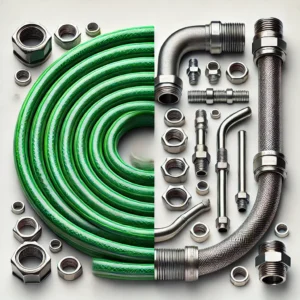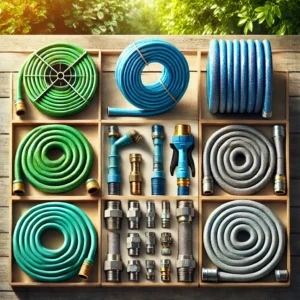Hose and Hose Pipe
The Complete Guide for Choosing the Best Fit For Your Needs

Introduction
Hoses and hosepipes are indispensable tools, whether you’re a homeowner or a professional in the construction, plumbing or gardening industries. How do you choose the right one? What is the difference between a garden hose pipe, water hose types, durable hoses at home, , etc.?
What Is a Hose?
A tube, at its heart, is a flexible and hollow tube that’s designed to carry fluids, gasses, or solid materials. It is typically constructed from synthetic, rubber or plastic materials depending on the intended purpose.
Hoses have a wide range of uses, from construction and agriculture to home gardening and healthcare.
What Is a Hose Pipe?
In countries such as the UK or India, “hose” is commonly used to refer to . This term is used to describe garden hoses that are typically used to water plants, wash cars or for other household purposes.
Although some people interchange the two terms, “hosepipe” is most commonly used to refer to flexible water supply tubes.
Key Differences Between Hoses and Hose Pipes
Features You can also use Hose Hose Pipe
Common Use Water, air and gases are all used for general purposes. Water-related applications are the most common.
- Material Rubber
- vinyl
- plastic Plastic
- PVC
- reinforced rubber
Application Industry and Household Gardening at home
Types of Hoses and Hose Pipes:

You can find the right hose or hose pipe for you by understanding the types. Here are the common types.
- 1. Garden Hoses
Garden hoses are the most commonly used hose pipes. The garden hose is lightweight and flexible and ideal for car washing and home gardening.
Features: - Rubber, vinyl or hybrid materials
The lengths are 25 ft., 50 ft., and 100 ft.
Easy connection with the brass or plastic fittings
Best for Gardeners, Homeowners and Casual Users
2. Water Hoses
- Hoses that are used for water transport can be classified as general purpose hoses. Depending on your needs, these hoses may be lightweight or heavy duty.
Types that are commonly used include:
- Drinking Water Hoses
- Hoses for heavy-duty applications.
3. Industrial Hoses
- They are designed to withstand extreme pressure, temperatures and chemical substances. These hoses are used on construction sites, in commercial and industrial operations, as well as factories.
Examples include:
- Hoses for transporting chemical substances
- Air Hoses
4. Flexible Hose Pipes
- These flexible hoses are perfect for any application that requires flexibility and bendability. They are lightweight and durable, commonly used for domestic plumbing, appliances, water heaters.
- Clusters of long-tail stems includes:
- “Best flexible water hose for domestic use”,
5. Soaker Hoses
- The soaker hose, a special garden hose that has tiny holes to allow the water to slowly seep through it and provide efficient irrigation of plants and lawns.
Benefits:
- Saving water
- Reduces evaporation
- Eco-friendly gardening is perfect for everyone
6. Expandable Hoses
- In recent years, the lightweight and space-saving design of expandable hoses has gained enormous popularity. When filled with water, they can expand to three times their original size.
Features:
- No tangles and no kinks
- Ideal for balconies or small gardens
Factors to Consider When Choosing the Best Hose or Hose Pipe
The following factors are important when choosing the correct hose or hosepipe:
1. Materials
- Vinyl – Affordable, lightweight and not durable
- Rubber: Flexible, strong, and resistant to weather.
- Blended material: Vinyl and rubber combined for increased
- durability and flexibility
2. Hose Length
- The length of hoses can range anywhere from 25 to 100 feet. Select a hose based on the usage you will be making.
- Small Patios and Balconies up to 25 feet
- 50 ft: Medium-sized gardens
- 100 feet: Industrial areas or large yards
3. Durability and Reinforcement
- For hoses that are heavy-duty, look for those with reinforced layers. Choose hoses that are “reinforced”, “industrial grade” or similar for heavy-duty jobs.
4. Fittings and Connectors
- Hoses, hose pipes, and fittings are often made of brass, aluminium, or plastic.
- Brass fittings Rust-resistant and leak-proof.
- Plastic fittings Less durable but lighter weight
5. Water Pressure Compatibility
- Make sure your hose can handle the water pressure you need. For car washes, sprinklers and pressure washers high-pressure hoses work best.
Top 5 Hose Pipes and Hoses for 2024
These are the top-rated hoses on the current market.
- Flexzilla garden hose Lightweight and durable.
- Expandable Grow Green Hose- Ideal for smaller gardens and saving space.
- Gilmour Heavy Duty Water Hose is the best for heavy duty tasks
- Camco Drinking Water hose- Perfect for RVs, safe for drinking water.
- Melnor Flat Soaker hose- Effective watering of plants and lawns
These hoses offer a combination of flexibility, durability and comfort for varying needs.
How to Maintain Your Hose and Hose Pipe
Your hose and hosepipe will last longer if you maintain them properly.
These tips will help you.
- After use, drain water- Prevent mold and leaks by avoiding the accumulation of water.
- Store Properly Use a hose hanger or reel to avoid kinks.
- Avoid Sun Exposure – UV rays can weaken hoses over time.
- Look for Leaks Replace washers and fittings if you find any.
Frequently Asked Questions (FAQs)
1.What is the difference between tubes and pipes?
- The terms tube and pipe are interchangeable in British English to refer to a flexible tube designed to transport fluids. In American English, however, the term “hose” is more commonly used. The two terms are not functionally different; they’re just regional preferences.
2.What is the difference between pipe and tubing?
- The differences in sizing and purpose between tube, tubes, are the most important.
- pipe: Measuring by the internal diameter of the tube (ID), and used to transport fluids or gas over long distances. This is often used for industrial or construction settings.
- Tube: Tubing that is measured by the external diameter of its tube. It’s used for precision applications such as medical devices and hydraulics. In smaller applications, tubing is more versatile and flexible.
3.What is the difference between a hose pipe and a hose reel?
- Hose pipe: This is the flexible tube used for transporting water or fluids.
- Hose reel A device that is designed to organize, store and wind a hosepipe, which makes it easier to use, and prevents tangles and damage.
4.What do Americans call a hose pipe?
- The term “hose ” is used in the United States instead of the “hose pipe”. A garden hose, for example is a flexible tubing used to water plants. In American English, the term “hosepipe” is not often used.
5.What size water hose to plumb boat ?
For most boat plumbing, 1/2 inch to 5/8 inch hoses are typically used for fresh water systems, sinks, and showers. For bilge pumps or high-flow systems, you may need 3/4 inch or 1 inch hoses. Always choose marine-grade hoses designed to resist saltwater and UV damage, and check the manufacturer’s recommendations for your specific boat systems.
Conclusion:
The choice between a garden hose or a flexible hose pipe is based on your needs and preferences. Understanding the different options will allow you to make an informed decision.
If you take care of the hose, it will last for many years.
2 Responses